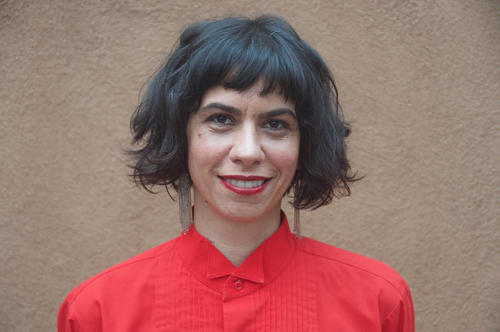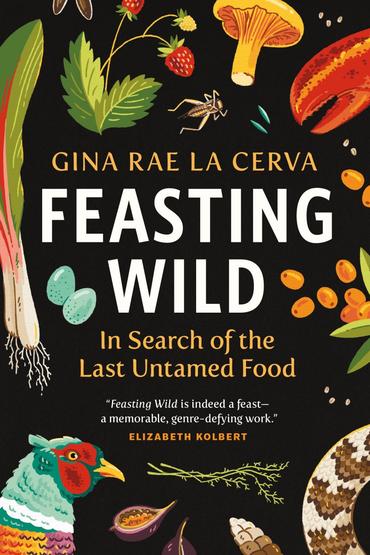
TRI recently sat down with author, geographer, F&ES alumna and TRI Fellow Gina Rae La Cerva to talk about her new book Feasting Wild.

Why did you write this book? What do you hope the book will accomplish?
It actually started out as an experiment! I turned 30 during my first semester at FES and decided I would try writing a book. My academic background was in geology, geography, and natural hazards risk management, so I figured I would write something about that topic. But during my second semester at Yale, I started to notice the increasing interest in wild foods—those that are hunted and gathered—including more people wanting to learn these skills, the preference and price-premium for wild-caught fish, and fancy restaurants increasingly serving wild foods to their clients. As I started looking into it, I found that many of these wild foods were becoming expensive, globally traded commodities often associated with criminal networks. At the same time, I was learning about the Anthropocene in my classes—this idea that humans have impacted so much of the planet that there is no such thing as “wild” nature left. It was a very interesting juxtaposition to explore. Why were we so enamored with wild foods right at the moment wild nature seemed to be on the brink of disappearing?
I hope that this book helps to expand our understanding of conservation. The ability to engage with wild nature as a place of salvation or recreation really depends on having the time, money, and privilege to do so. So, the book examines how we can make access to both wild nature and wild food equitable, especially given the historical colonial and racist roots of much of modern-day environmentalism. How do we prevent wild foods and wild nature from just becoming commodities that fall under the logic of capitalism? How do we grieve the massive species loss we are witnessing? How do we understand our own role within the world’s ecologies?
How did your experience as a TRI Fellow play into the research and writing of the book?
I was very grateful to receive TRI funding, and it was through this fellowship that I was able to conduct research the wild meat trade in the Democratic Republic of Congo (DRC). This food is in the middle of a transformation, from a basic subsistence staple to a luxury dish in cities, and is becoming unaffordable for the majority of people.
Because there is very little tourism in DRC, and much of the wild meat trade is tied up in the violent black market, I couldn’t just show up and start asking questions. It was through the TRI network that I was able to find a conservation organization to host me and help with on the ground logistics.
After I returned from my research trip, I wrote a paper for the Tropical Resources Bulletin, and this eventually became one of the central chapters in my book. Writing about both the social and natural science aspects of this work allowed me to more fully capture the human experiences of those involved in this trade.
Can you talk about the research process for the book?
The book required a lot of on the ground research in places including DRC, Poland, Borneo, and Sweden. There is even a chapter set in the abandoned Winchester gun factory in New Haven. I then combined the on-the-ground experiences with extensive historical research. At some point, I had so many books checked out of the library that I reached my maximum limit and had to convince friends to check out additional books for me. It was so important to me to fit my field research into the larger historical context. I drew a lot of maps of the book to visualize how the stories I was telling were connected because I wanted to write a chronological narrative that didn’t feel predictable. I aimed to write something multi-layered, something that did not present a singular viewpoint of the “wild” but felt organic in the way it moved between ideas. So, taking this two-dimensional map and turning it into a sequential book was really challenging and interesting.
What does success with this book look like?
I am really curious to see what people take from this book, what resonates with them, whether they see it as tragic story or a story of hope. I resisted writing a book with concrete prescriptions for action because while those are necessary, and many smart people have given us a lot of good ideas, I was more interested in a different type of transformation. The changes we need are systemic—all systems of oppression are interrelated. So, it’s important that environmentalists unpack the entrenched issues in our work. For example, the creation of our nation’s National Parks was the result of kicking Indigenous peoples off of their lands. Many current conservation measures have racist roots. Gifford Pinchot, the so-called father of environmentalism was a eugenicist. We must understand the patriarchal, racist, and colonialist biases in the environmental field to avoid unintentionally perpetuating them.
Because of this history, the voices and environmental knowledge of women, Indigenous, enslaved, and marginalized voices were often actively erased. How do we move forward and rebuild this lost history? How do we retell this story of our relationship to wild foods and wild nature? We always think of the stone ax as the first prehistoric tool. But most likely, the first tools were woven satchels used to carry gathered food home. The stone tools survived archaeological time, while the satchels degraded. Similarly, this book aims to help us remember what has been lost.
What was the hardest part of the book to write?
After four years of work, I submitted the manuscript, and my editor said “This is great, but we need you to do a rewrite” This ended up being an important part of the process because I added a lot more personal perspective into the book—what I was feeling during my research, my love story with a man I just call The Hunter, my childhood in New Mexico … It was hard to excavate my own experience and decide how much to expose—what kind of character I wanted to create for myself and what pieces of the truth to share. But in the end, the intertwining of the personal, scientific, and historical actually made it a much more beautiful, complex book. And I think this cadence and rhythm, allowing the reader go back and forth between these differing narratives, is really important and satisfying.
Interesting … why is being able to wrap those themes together so important?
We have to recognize that the personal lens we take to our work is going to influence how we see the work and what solutions we choose. We have to interrogate ourselves to make sure the work we are doing is truly equitable, inclusive and beneficial to the planet. If we don't, we can be blinded to the way forward. On the other hand, science and history allow us to see larger patterns. So, I think presenting both the personal and the larger context gives us a much richer picture of the world.
What would 2020 Gina Rae tell the Gina Rae who was about to start this book?
I would tell myself to just keep trusting what I am doing. I have always been someone who enjoys new challenges, and sometimes the learning process is more interesting to me than the outcome. I love to write, but there were many times over the last six years when I was ready to throw my computer on the sidewalk and just give up on the book. I would tell myself to just keep trusting the commitment to the process, that it was worth the difficulty and to have a little more faith in myself. We are always bumbling around in the dark to some degree and often times those are the most expansive and important moments in our lives.
Is there anything else you want to share?
During the course of my research, there were times when people didn't want to talk to me, or didn't take me seriously. If I had accepted that perspective, I never would have gotten the project done. So, I encourage young scientists, particularly female researchers, to not be afraid of going out there and asking questions. It's so important to believe in your own quest for knowledge.
Where can people buy the book?
The book is available anywhere books are sold. I encourage everyone to buy it from an independent bookstore.